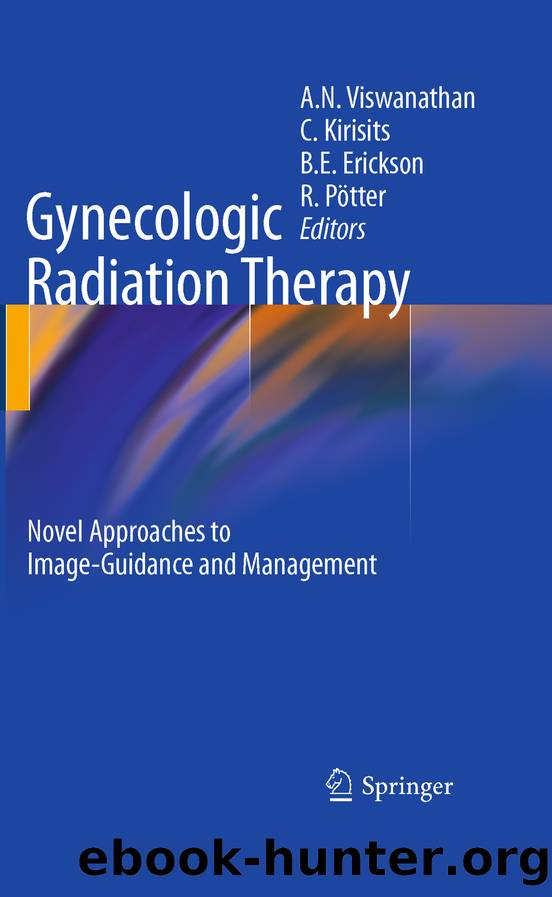Gynecologic Radiation Therapy by Akila N. N. Viswanathan Christian Kirisits Beth E. E. Erickson & Richard Pötter

Author:Akila N. N. Viswanathan, Christian Kirisits, Beth E. E. Erickson & Richard Pötter
Language: eng
Format: epub
Publisher: Springer Berlin Heidelberg, Berlin, Heidelberg
12.2.5 Applicator Reconstruction Using MR Images
Localizing the source path from MR images is challenging because conventional markers used for X-ray and CT cannot be used in magnetic resonance imaging (MRI). Special MR markers like catheters containing a fluid CuSO4 solution [11], water [12], or glycerin [13] can be used in plastic applicators (Fig. 12.2), although the signal from these MR markers can be faint in T2-weighted images when using applicators with narrow entrance diameters. In titanium applicators, fluid contrast cannot be visualized inside the source guide tubes due to susceptibility artifacts. Slice thickness is an important parameter for reconstruction, since it has direct impact on the precision of reconstruction. It is recommended to perform reconstruction in image series obtained with a slice thickness less than or equal to 5 mm. Furthermore, para-transverse imaging visualizes the applicator better than with transverse imaging. 3D sequences with isotropic voxel sizes produce an excellent visualization of the applicator, and it is also possible to do contouring in certain T2-weighted 3D sequences [14]. Performing contouring and reconstruction in the same image series is an advantage when possible, because this eliminates uncertainties introduced by registering different image series. Moreover, it avoids uncertainties due to the artifact shifts that change with pulse sequence [15]. In many cases, an artifact is indicating the location of the applicator while the true applicator position is not directly visible. When using metallic applicators in particular, care should be taken to verify the geometric relationship between the true applicator position and the artifacts from the applicator.
Fig. 12.2Transversal and coronal (reconstructed) magnetic resonance (MR) images with a plastic tandem–ring applicator in situ. Thin catheters containing a CuSO4 solution in water have been inserted into tandem and ring channels, and appear as bright contrast in the signal void of the applicator material
Download
This site does not store any files on its server. We only index and link to content provided by other sites. Please contact the content providers to delete copyright contents if any and email us, we'll remove relevant links or contents immediately.
When Breath Becomes Air by Paul Kalanithi(7253)
Why We Sleep: Unlocking the Power of Sleep and Dreams by Matthew Walker(5636)
Paper Towns by Green John(4163)
The Immortal Life of Henrietta Lacks by Rebecca Skloot(3819)
The Sports Rules Book by Human Kinetics(3581)
Dynamic Alignment Through Imagery by Eric Franklin(3481)
ACSM's Complete Guide to Fitness & Health by ACSM(3459)
Kaplan MCAT Organic Chemistry Review: Created for MCAT 2015 (Kaplan Test Prep) by Kaplan(3418)
Introduction to Kinesiology by Shirl J. Hoffman(3297)
Livewired by David Eagleman(3113)
The River of Consciousness by Oliver Sacks(2988)
Alchemy and Alchemists by C. J. S. Thompson(2908)
The Death of the Heart by Elizabeth Bowen(2895)
Descartes' Error by Antonio Damasio(2727)
Bad Pharma by Ben Goldacre(2722)
The Gene: An Intimate History by Siddhartha Mukherjee(2487)
Kaplan MCAT Behavioral Sciences Review: Created for MCAT 2015 (Kaplan Test Prep) by Kaplan(2483)
The Fate of Rome: Climate, Disease, and the End of an Empire (The Princeton History of the Ancient World) by Kyle Harper(2429)
The Emperor of All Maladies: A Biography of Cancer by Siddhartha Mukherjee(2427)
